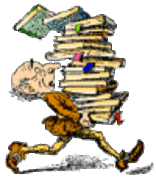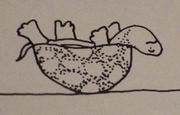Shells of Reading Strategies
Good Reading Strategies
Looking at Headlines
Write out the headline in a complete sentence.
Explain the headlines: Dear reader, you'll find interesting/new/amusing
Information/facts/ideas/events about...
What do you know about the topic?
What do you want to know about the topic?
Which words go with the topic?
Write down the questions the text may answer.
Ask your teacher: Will the text say anything about...?
Skimming
There are ten titles for the paragraphs, but we need only six. Which would you choose?
Choose the most important points from the list and put them in the right order.
Compare your previewing questions or predicting statements with the text.
Which additional information have you found? Write it down in one key word.
Which are the most important words of the text? Write them down and compare your list with your neighbor's.
Underline the most important words or mark them with a highlighter.
How many different paragraphs does the text have?
What are the main ideas?
Scanning
Read the text again and underline the following words as quickly as possible: key words, synonyms, opposites, associated words...
Where does the text say that...paraphrase.
What does it, they, this or that, which or who, pronouns relate to?
Try to find evidence for the correctness of one or two of your answers.
Comprehending
Find evidence for the following statements...
Mark those groups of words that form phrases and are seperated by a pause with this sign:
Find the correct sequence of lines.
Give a summary of the main ideas of the text. Justify it.
Preparation for Reading Textbooks
When you first get your textbook it may seem like the book has facts and ideas that are overwhelming and unmanageable. Textbooks are highly organized sources of information that are well structured. They follow specific patterns of organization and are uniform and predictible in format and style. Research in educational psychology indicates that if readers have some knowledge of content and organization before they begin to read their comprehension and recall increases.
Table of Contents
The table of contents is a valuable part of surveying your textbook. Always read it first so that you can get a good idea of what the book is all about before you even begin to read it. The table of contents is an outlie of the textbook's main topics and subtopics. It shows the organization of the text and indicates the interrelations among the topics. Often it reveals thought patterns used throughout the text.
Besides using the table of contents to preview a text's overall content and organization, be sure to refer to it before reading certain chapters. Even though chapters are organized as separate units, they are interrelated. To understand a certain chapter, note what topics come right before and right after it.
Previewing
Previewing improves concentration and comprehension. Educational psychology research indicates that if readers have some knowledge of content and organization of material before beginning to read, it increases their recall and comprehension.
Before, during and after reading strategies are important. Before reading, use chapter previews in order to activate prior knowledge in your students regarding the subject. Have them recall what they already know about the subject by trying to anticipate the main points of the chapter.
During reading use previewing as a guide to what material is important to learn. Mark or underline key information mentioned in the preview.
After reading use the preview in order to monitor the effectiveness of reading. Test student ability to recall key information and have students do this after their reading. Have them immediately review any material that they were unable to recall.


